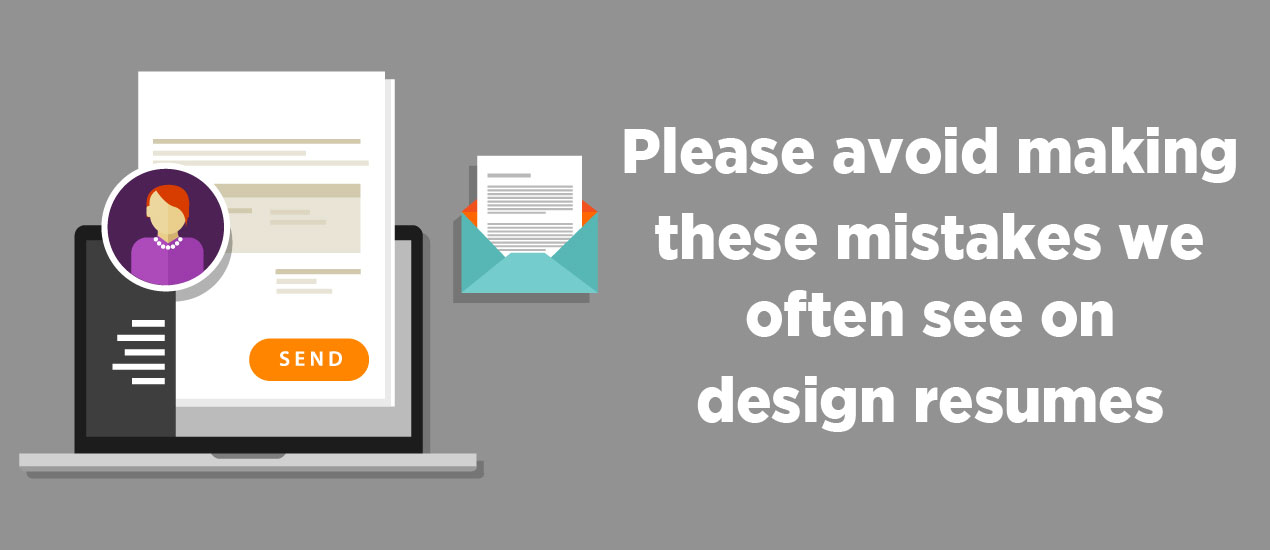Blog

Please Avoid Making These Mistakes We Often See on Design Resumes
Please Avoid Making These Design Resume Mistakes
Hello job seekers! We’re back to talk about what it takes to get the dream design job you’re after. Last week, we discussed, “The Magic Element to Include in Best Graphic Design Cover Letter Ever.” If you missed the post, please go back and check it out.
Today, we’re moving on to part two of your submission to the graphic design studio of your dreams – the resume. Before we go on, quick note: We highly recommend applying to companies you’re interested in working for even if they’re not advertising any open positions. Some companies get so many applicants that they don’t advertise. Some companies may not be hiring, but if a strong candidate comes to them and says: “Hey – I ONLY want to work for YOU.” they may consider it. It can’t hurt right? Right.
Okay, let’s get into it! Here are a few mistakes we see quite often on design resumes, as told by our President, William Beachy:
Failing to design your resume and cover letter. Shockingly, this is frequently not done. Many designers use a basic Word resume template. A candidate once told me that their design professor specifically told them to use a plain-jane Word template. I’m not sure where this professor got their information from (maybe the year 1950), but I think that professor was wrong. Your resume, cover letter and web-portfolio need to be a perfectly matched set, and they should be as pretty as everything in your portfolio. As I said before, this is the FIRST IMPRESSION you’re giving your potential employer. Make it shine!
When designing your resume, don’t be afraid of getting creative! Bold type and infographics can be a plus – so long as they are handled well. A concept behind your application is also a plus. I had an applicant give me a resume that was a ‘Top Ten’ list. Specifically, it said: “Top ten reasons you should hire me.” Then she creatively worked all her education and experience into a list of ten items.
Rating your skill level on various software. I see this constantly. It says something like: Illustrator 90% | Photoshop 95% | Word 85%. What does that even mean? Is there a standardized test that I’m not aware of? It’s funniest when I see stats like this, but the applicant’s portfolio sucks. First of all, I’ve been using Illustrator for 20+ years and I’m only at maybe 85% proficient with it. So, how are you – a student who is just graduating at 90%. The simple fact is this means nothing. Don’t try to put a stat to how proficient you are in your software knowledge. The employer will know exactly how proficient you are based on the quality of the work in your portfolio. Instead a simple list of software you know how to use with no additional qualifiers is fine.
Adding extra fluff. Remove any and all work experience that is not art or design related. The fact that you taught kids martial arts is great, but I prefer my candidates come across like their entire life is focused on art and design. You can imagine my feelings when I see a resume that says: “McDonalds (cook), Progressive (insurance salesman), Lincoln Electric (assembly), Chipotle (cook), Freelance Designer.” It paints a picture of someone who has not been focused on design! This candidate would be better off if they left off ALL their previous experiences, and just said: Freelance Designer.
Now obviously, if this topic is brought up in an interview… do not lie! Tell them all about the other previous work experiences you’ve had and what you learned from them and how those will apply to your new position. And if they ask why those were left off your resume, just say: “I didn’t think those jobs were applicable to this position.”
With this approach… they think of you as a DESIGNER FIRST… who has some other life experiences… as compared to a resume that makes you look like an EVERYTHING ELSE FIRST… oh… and with a little design experience too.
See the difference in that?
Ok, now that we’ve covered our mistakes to avoid on design resumes, promise us you’ll do your best to do so.
Stay tuned, as next week we’ll be back with our favorite rules about creating the best design portfolio ever.